Overview of Ashta Lakshmi Stotram
The Ashta Lakshmi Stotram is a sacred Telugu hymn dedicated to Goddess Lakshmi, praising her eight divine forms. It is a powerful prayer for prosperity, wisdom, and spiritual growth, widely revered in Hindu devotion.
Goddess Ashta Lakshmi represents the eight divine forms of Lakshmi, the Hindu deity of wealth, prosperity, and good fortune. These forms symbolize different aspects of wealth, including material, spiritual, and intellectual. The eight forms are: Adi Lakshmi (primordial wealth), Dhana Lakshmi (material wealth), Dhairya Lakshmi (courage and patience), Gaja Lakshmi (prosperity), Santana Lakshmi (progeny), Vijaya Lakshmi (victory), VIDYA Lakshmi (knowledge), and Bhagya Lakshmi (good fortune). Each form embodies a unique attribute, making Ashta Lakshmi a comprehensive symbol of holistic well-being. Worshipped across India, particularly in Telugu-speaking regions, she is revered for granting blessings in all aspects of life.

Significance of the Eight Forms of Lakshmi
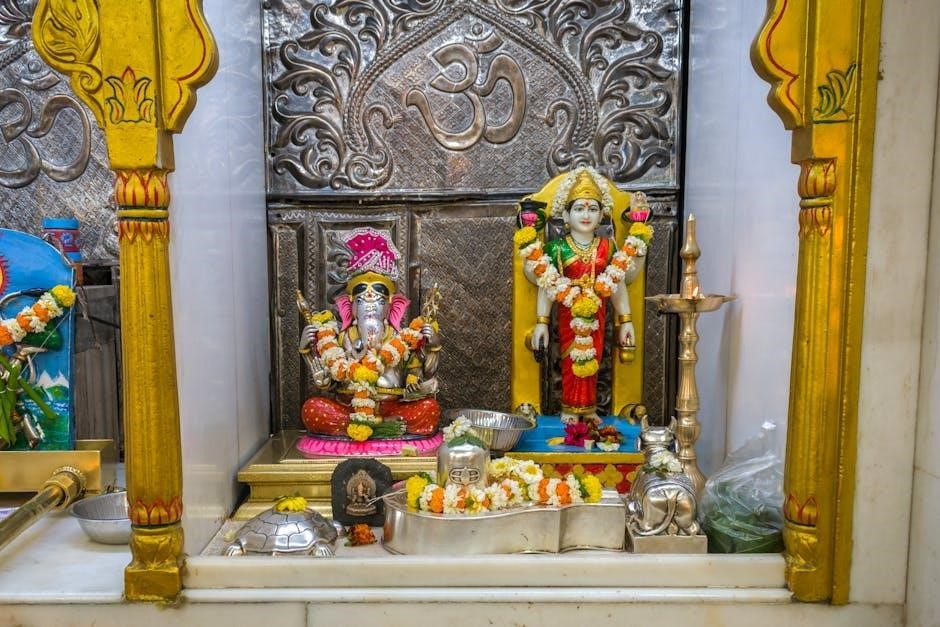
The eight forms of Lakshmi, known as Ashta Lakshmi, hold profound spiritual and cultural significance. Each form embodies a distinct facet of wealth and prosperity, ensuring a balanced and fulfilling life. Adi Lakshmi symbolizes the origin of wealth, while Dhana Lakshmi grants material abundance. Dhairya Lakshmi instills courage and patience, essential for overcoming life’s challenges. Gaja Lakshmi represents elephants, signifying prosperity and good fortune; Santana Lakshmi blesses devotees with children and a harmonious family life. Vijaya Lakshmi ensures victory in endeavors, and VIDYA Lakshmi bestows knowledge and wisdom. Lastly, Bhagya Lakshmi grants good fortune and destiny. Together, these forms encapsulate the holistic blessings of Goddess Lakshmi, making her a revered deity in Hinduism.
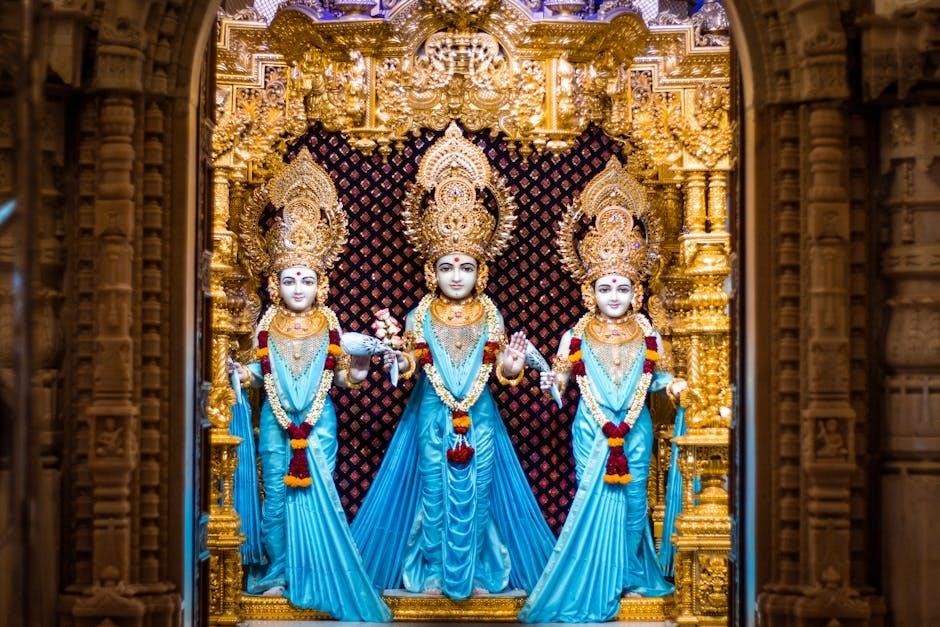
Structure and Content of the Stotram
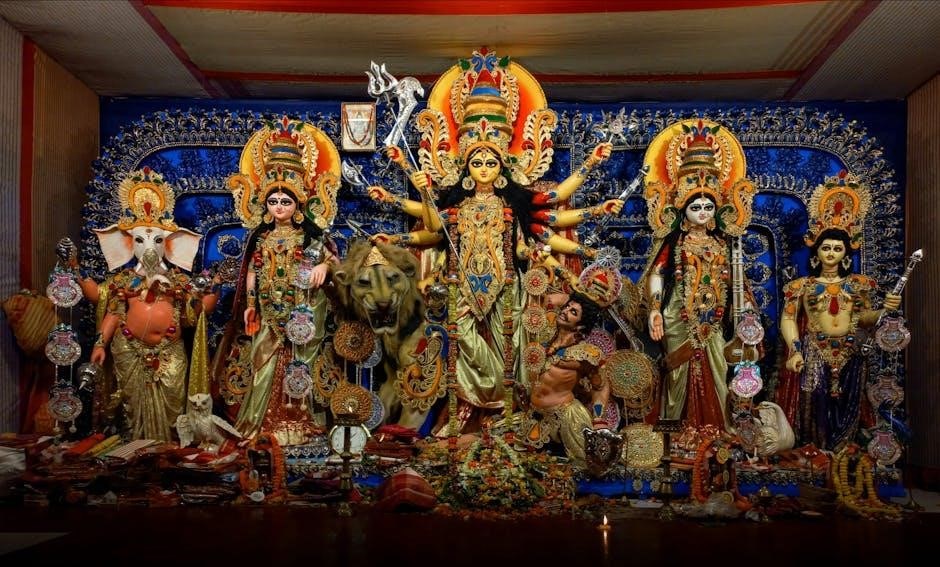
The Ashta Lakshmi Stotram is an 8-verse hymn in Telugu, each dedicated to one form of Lakshmi, describing her divine attributes and blessings for prosperity and enlightenment.
Eight Verses and Their Meanings
The Ashta Lakshmi Stotram comprises eight verses, each glorifying a distinct form of Goddess Lakshmi. The first verse honors Adi Lakshmi, the primordial form, symbolizing timeless prosperity. The second verse praises Dhanya Lakshmi, bestowing wealth and abundance; Dhairya Lakshmi is celebrated in the third verse for courage and strength. The fourth verse dedicated to Gaja Lakshmi signifies royal prosperity. Santan Lakshmi in the fifth verse grants progeny and family bliss. The sixth verse honors Vijay Lakshmi, ensuring victory and success. The seventh verse praises Vidya Lakshmi for knowledge and wisdom. Finally, the eighth verse glorifies Dhana Lakshmi, the giver of material wealth. Each verse is a heartfelt prayer seeking blessings for a fulfilling life.
Language and Cultural Context
The Ashta Lakshmi Stotram is composed in Telugu, a language deeply rooted in South Indian culture, particularly in Andhra Pradesh. This sacred hymn is a vital part of Telugu devotional literature and is widely recited during religious ceremonies and daily worship. The stotram’s verses are written in a simple yet profound style, making them accessible to devotees of all backgrounds. Its cultural significance is immense, as it reflects the reverence for Goddess Lakshmi in Telugu-speaking communities. The use of Telugu enhances the spiritual and emotional connection, allowing devotees to express their devotion authentically. The stotram is often sung during festivals like Diwali, emphasizing its role in preserving cultural and religious traditions. Its availability in PDF format ensures it reaches a broader audience, bridging the gap between tradition and modernity;
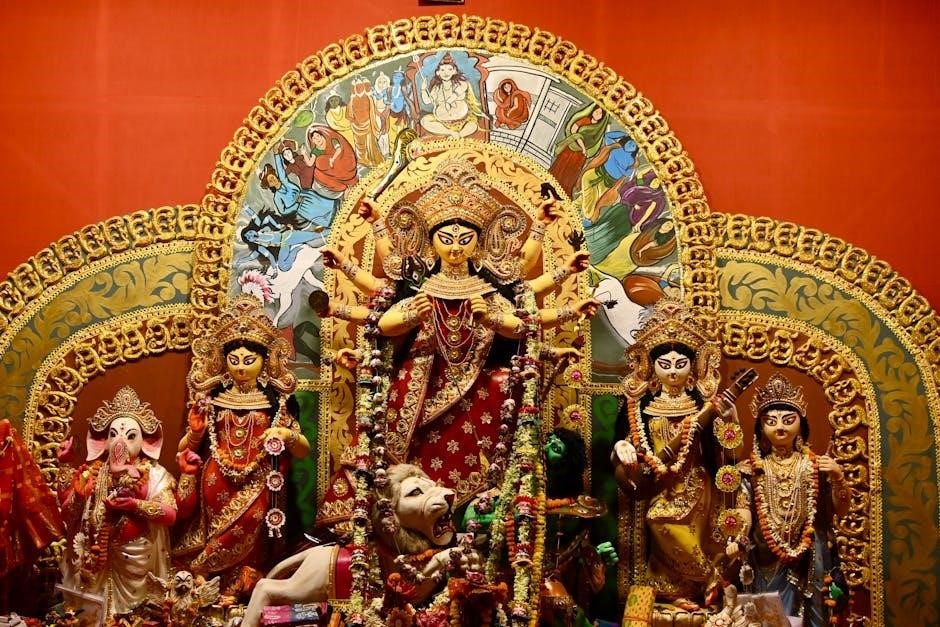
Benefits of Reciting Ashta Lakshmi Stotram
Reciting the Ashta Lakshmi Stotram brings spiritual growth, prosperity, and peace. It enhances wisdom, fortune, and happiness, benefiting career, relationships, and life’s overall harmony.
Spiritual and Material Benefits

The Ashta Lakshmi Stotram offers profound spiritual and material benefits. Spiritually, it fosters inner peace, divine connection, and liberation. Materially, it attracts wealth, success, and abundance, fulfilling desires. Regular recitation enhances fortune, prosperity, and happiness, while promoting harmony in life. It is believed to bring positive energy, uplift career prospects, and strengthen relationships. For devotees, the stotram serves as a powerful tool to invoke Goddess Lakshmi’s blessings, ensuring both worldly comforts and spiritual enlightenment. Its verses are said to ward off adversity, granting protection and prosperity. Many recite it to achieve balance in life, seeking both material success and spiritual growth.
Importance in Telugu Devotional Practices
The Ashta Lakshmi Stotram holds significant importance in Telugu devotional practices, being a cherished hymn in daily worship. It is widely recited during Lakshmi Puja, Navratri, and other auspicious occasions, symbolizing devotion to Goddess Lakshmi. The stotram’s Telugu version resonates deeply with Telugu-speaking communities, making it a staple in temple rituals and home prayers. Its verses are often chanted for blessings of prosperity, wisdom, and spiritual growth. The availability of the Telugu PDF version has further enhanced its accessibility, allowing devotees to recite it effortlessly. This stotram is also sung in cultural festivals, fostering a sense of unity and faith among participants. Its profound cultural and religious significance makes it a cornerstone of Telugu devotional traditions, enriching spiritual practices and daily life.

Downloading the Telugu PDF Version
The Ashta Lakshmi Stotram Telugu PDF is easily accessible online, free to download, and available on various devotional websites. Its convenient format ensures easy readability and recitation.
Availability and Sources
The Ashta Lakshmi Stotram Telugu PDF is widely available for free download on various devotional websites. Platforms like Telugu Devotional Songs, Swaranjali, and Stotra Nidhi offer easy access to the document. Additionally, it can be found on blogs and forums dedicated to Hindu spirituality. The PDF is often provided in formats such as .pdf or .txt, ensuring compatibility with different devices. Many websites also allow users to read the stotram online without downloading, making it convenient for global devotees. The document typically includes the Telugu script along with its English transliteration, catering to both native and non-native speakers. This accessibility has made the Ashta Lakshmi Stotram a popular choice for daily recitation and spiritual practices.
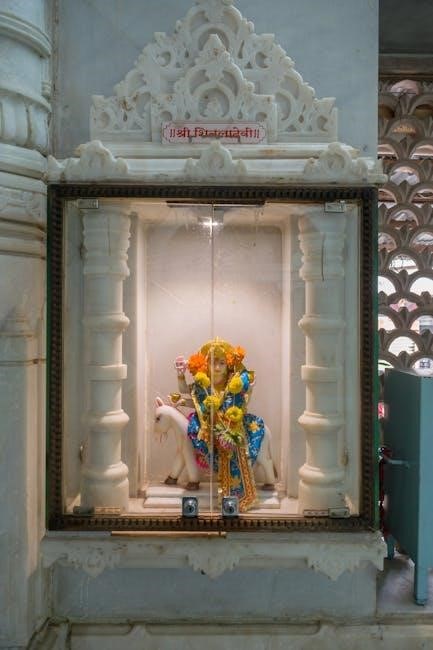
How to Access the PDF File
To access the Ashta Lakshmi Stotram Telugu PDF, visit reputable devotional websites like Stotra Nidhi or Telugu Devotional Songs. Use search engines with keywords such as “Ashta Lakshmi Stotram Telugu PDF free download.” Click on trusted links, and you will be directed to the download page. Select the desired format (e.g., .pdf or ;txt) and save it to your device. Ensure the source is reliable to avoid malicious files. Many websites also offer the option to read the stotram online without downloading. This easy accessibility makes it convenient for devotees worldwide to recite and worship using the digital version of the sacred hymn.
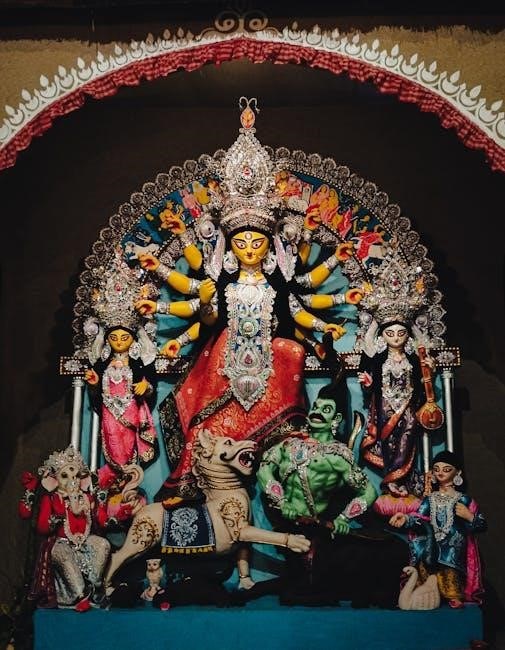
Religious and Cultural Significance
The Ashta Lakshmi Stotram holds profound religious and cultural significance, symbolizing Goddess Lakshmi’s eight divine forms. It is integral to Hindu rituals, festivals, and daily worship, embodying spiritual and material prosperity.
Role in Hindu Worship and Rituals
The Ashta Lakshmi Stotram plays a vital role in Hindu worship, often recited during religious ceremonies and daily rituals. It is an integral part of Lakshmi Puja, performed during Diwali, invoking Goddess Lakshmi’s blessings for prosperity. The hymn is commonly chanted in temples and homes, especially during auspicious events like weddings and festivals. Its verses are believed to bring spiritual and material harmony, making it a cherished prayer in Hindu devotion. The stotram’s recitation is also considered a powerful way to seek divine grace for wealth, wisdom, and good fortune. Its cultural significance is profound, reflecting the deep reverence for Goddess Lakshmi in Hindu tradition. It continues to be a cornerstone of devotional practices, fostering a connection between the devotee and the divine.
Connection to Goddess Lakshmi
The Ashta Lakshmi Stotram is deeply connected to Goddess Lakshmi, the Hindu deity of wealth, prosperity, and wisdom. It glorifies her eight divine forms, each symbolizing a unique aspect of her blessings. The hymn is a heartfelt invocation of Lakshmi, seeking her grace for both material and spiritual well-being. Goddess Lakshmi, often depicted with four arms holding a lotus, embodies the essence of divine abundance and purity. The stotram’s verses reflect her nurturing and protective nature, resonating with devotees seeking her benevolence. By praising her eight forms, the prayer fosters a profound spiritual connection, reinforcing her significance in Hindu devotion and culture. This sacred hymn is a testament to Lakshmi’s enduring relevance as a symbol of prosperity and divine harmony.
